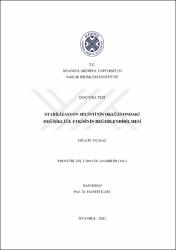| dc.contributor.advisor | Kurt, Hanefi | |
| dc.contributor.author | Yılmaz, Gülçin | |
| dc.date.accessioned | 2022-01-27T09:22:50Z | |
| dc.date.available | 2022-01-27T09:22:50Z | |
| dc.date.issued | 2021 | en_US |
| dc.date.submitted | 2021-07-01 | |
| dc.identifier.citation | Yılmaz, G. (2021). Stabilizasyon splintinin oklüzyondaki değişikliğe etkisinin değerlendirilmesi. (Yayınlanmamış doktora tezi). İstanbul Medipol Üniversitesi Sağlık Bilimleri Enstitüsü, İstanbul. | en_US |
| dc.identifier.uri | https://hdl.handle.net/20.500.12511/8919 | |
| dc.description.abstract | Bu çalışmanın amacı, iki farklı dijital oklüzal kayıt cihazı ile temporomandibular rahatsızlıkların (TMR) tedavisinde kullanılan stabilizasyon splintinin 3 aylık kullanımı sonrası oklüzyonda meydana gelen değişimin değerlendirilmesidir. TMR'ye sahip 20 gönüllü birey ve sağlıklı temporomandibular ekleme sahip 20 gönüllü bireylerden oluşmak üzere toplam 40 bireyin dahil olduğu çalışmada, tüm gönüllü bireylerin başlangıç ve oklüzal kayıtları T-SCAN ve OccluSense ile alındı. TMR'ye sahip gönüllü bireylere premolar bölgesinde 3 mm yükseltme yapılacak şekilde sert stabilizasyon splintleri yapıldı. Bu splintlerin; 7.gün, 1. ay, 2. Ay ve 3. Ay olmak üzere düzenli kontrolleri ve uyumlamaları yapıldı. 3 ayın sonunda 40 gönüllü bireyin tamamından T-SCAN ve OccluSense ile oklüzal kayıtları yeniden alınarak tedavi öncesi ve sonrası oklüzal temasları ve farklı dijital kayıt cihazları ile elde edilen sonuçlar karşılaştırıldı. Splint uygulanan ve kontrol grubunda olan hastaların tedavi öncesi ve sonrası oklüzal temasları arasında istatistiksel olarak anlamlı bir fark görülmedi. Sonuç olarak sert stabilizasyon splinti ile tedavi edilen TMR'ye sahip hastaların oklüzyonunda 3 aylık kullanım sonucu değişiklik olmadığı ve T-SCAN ile OccluSense cihazlarının ölçümlerinin uyumlu olduğu görüldü. | en_US |
| dc.description.abstract | The aim of this study is to evaluate the change in occlusion after 3 months of use of a stabilization splint used in the treatment of temporomandibular disorders (TMD) with two different digital occlusal recorders. In this study, which included a total of 40 individuals, consisting of 20 volunteer individuals with TMR and 20 volunteer individuals with healthy TME, the initial and occlusal records of all volunteer individuals were taken with T-SCAN and OccluSense. Hard stabilization splints with 3 mm distance in the premolar region were given to volunteers with TMR. Regular checks and adjustments of these splints were made at 7th day, first, second and third months. At the end of 3 months, occlusal records with T-SCAN and OccluSense were re-taken from all 40 volunteer individuals and occlusal contacts in order to compare before and after treatment and results obtained with different digital recorders. There was no statically significant difference between the pre- and post-treatment occlusal contacts of the patients of the control and treatment groups. As a result, it was determined that there were no changes in the occlusion of TMR patients treated with hard stabilization splints after 3 months of use and the measurements of T-SCAN and OccluSense devices were compatible. | en_US |
| dc.language.iso | tur | en_US |
| dc.publisher | İstanbul Medipol Üniversitesi Sağlık Bilimleri Enstitüsü | en_US |
| dc.rights | info:eu-repo/semantics/openAccess | en_US |
| dc.subject | OccluSense | en_US |
| dc.subject | Stabilizasyon Splinti | en_US |
| dc.subject | Temporomandibular Rahatsızlıklar | en_US |
| dc.subject | T-SCAN | en_US |
| dc.subject | OccluSense | en_US |
| dc.subject | Stabilization Splint | en_US |
| dc.subject | Temporomandibular Disorders | en_US |
| dc.subject | T-SCAN | en_US |
| dc.title | Stabilizasyon splintinin oklüzyondaki değişikliğe etkisinin değerlendirilmesi | en_US |
| dc.title.alternative | Evaluation of the effect of stabilization splint on change in occlusion | en_US |
| dc.type | doctoralThesis | en_US |
| dc.department | İstanbul Medipol Üniversitesi, Sağlık Bilimleri Enstitüsü, Protetik Diş Tedavisi Ana Bilim Dalı | en_US |
| dc.relation.publicationcategory | Tez | en_US |


















